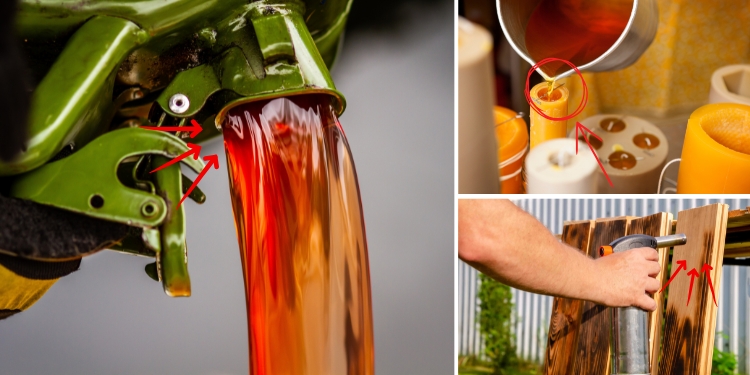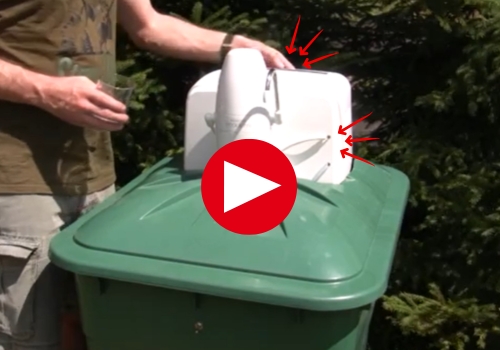Today, when most people think of fuels, they instantly picture electricity, gasoline, diesel, or natural gas. But long before the grid took over, humans relied on a wide range of alternative fuels. We’ve forgotten many of these—or pushed them aside in favor of convenience—even though they remain easily accessible to resourceful preppers.
With that in mind, here are 10 forgotten fuels you can still use today. Some might already be hiding in your pantry, backyard, or garage.
Charcoal
What we today call “Lump” charcoal is one of humanity’s oldest fuels and remains an efficient, portable source of heat and energy. It burns hotter than wood, produces less smoke, and stores well for years when kept dry.
In many parts of the world, charcoal is still a primary cooking fuel. You can store it in a waterproof container for years, and it will still burn.
It’s pretty easy to make yourself, by simply heating dried wood in a semi-sealed vessel with the limited presence of oxygen. I used to do it every weekend when burning the brush from some old down oak trees. You can even build your backyard charcoal kiln from a 55-gallon drum.
Animal Tallow & Lard
 Long before the world became dependent on petroleum, people used animal fat and tallow for light and heat. Rendered tallow or lard can be used in oil lamps or even as emergency candles. You can even use it as high-energy cooking fuel when you’re out of modern oils.
Long before the world became dependent on petroleum, people used animal fat and tallow for light and heat. Rendered tallow or lard can be used in oil lamps or even as emergency candles. You can even use it as high-energy cooking fuel when you’re out of modern oils.
My grandfather used to render tallow and lard from every animal he butchered. Then kept it in coffee cans and sealed drums deep in the root cellar. Ideally, you want to store it in sealed containers in a cool, dark place to maximize the shelf life.
The Amish, also, still rely on tallow and lard for lighting and heating in many communities, especially where electricity is banned by their Ordnung.
It’s a quiet reminder that some of the most reliable fuels have been with us for centuries and don’t require a single volt of power. You can learn more about it by reading The Amish Ways Book (click here to get one of the last copies available)!
Used Cooking Oil
Restaurants toss out gallons of used cooking oil every day. With a little know-how and the right equipment, this seemingly useless cooking can be converted into biodiesel. It can then be used directly in modified diesel engines.
Related: How To Make Biodiesel Fuel: Beat the System, Power Yourself
I used to know an old survivalist who came to town at the crack of dawn every Wednesday in his modified International Harvester diesel pickup truck. Then he’d siphon the decanted oil off the top of the restaurant barrels before the waste disposal service came through town on Wednesday afternoon.
Cottonseed Oil
For over a century, people across the southern U.S. commonly used cottonseed oil as a biofuel. They extracted it from cotton seeds and burned it in oil lamps. With the right equipment and know-how, you can also process cottonseed oil into biodiesel.
This plant-based fuel offers decent energy content and frequently powered homes in rural areas where cotton farming thrived.
Wood Gas
Syngas, known more commonly as “Wood Gas,” is a combustible gas produced by heating wood or biomass in a low-oxygen environment. When petroleum was in short supply during World War Two, many people in rural areas of Europe modified their cars to run on wood gas.
Today, you can still build a wood gasifier to power small engines, generators, or cookstoves.
I’ve done this as a science project for a high school chemistry class.
There was a pretty serious fireball the first time, but I managed to figure out how to do it in a controlled manner. If I can figure it out at 17, at the expense of all my arm hair, anyone can do it.
Just keep in mind — if you’re planning to rely on any small engine post-collapse, make sure it’s protected against EMP.
A single solar flare or high-altitude detonation could fry unshielded electronics in seconds. That’s why Faraday bags or EMP shields like this EMP Cloth are no longer optional for prepping.
Distilled Alcohol
Distilled alcohols like ethanol and methanol can be used in alcohol stoves or modified engines. Ethanol is also a common disinfectant and sterilizer, making it doubly useful in survival situations. You can make it from fermentable plant materials such as corn, malted grain, sugar cane, or fruit.
Yes, you could even create your own moonshine. Not that I’m advocating that. However, in a survival situation, you could ferment fruit peels and waste grain, then use the undrinkable “Heads” at the start and “Tails” at the end as a fuel source.
Of course, distilling anything — alcohol, water, even essential oils — takes fuel, time, and clean input. In a survival scenario, having an independent water source is even more important than fuel. That’s why you should invest in solutions like The Water Freedom System, which can extract drinking water from thin air, using simple condensation technology.
The method is so effective that it has been adopted on the toughest frontlines around the world by armies such as the U.S., U.K., France, Israel, Mexico, and India. If you’re looking for an efficient way to get water, this is as good as it gets. Click here and see how you can set up the system right in your own household!
Dung Manure Bricks
As unglamorous as it sounds, dried animal dung is one of the most common fuels in the history of man. It was one of the main fuels for the Native Americans and pioneers of the Great Plains. Even today, in rural parts of India and Africa, cow dung and horse manure are dried into bricks and burned for heat and cooking. It’s slow-burning, renewable, and requires no fancy tech.
Corn Cobs
Subsistence farm families in mid-latitude areas used to burn dried corn cobs, stalks, and other ag byproducts for cooking and heating. Dried husks ignite easily and can be used to start fires, while cobs burn hot and create embers that last longer than you might think. Most old-fashioned wood stoves and mass heaters can run on this kind of dried biomass.
Beeswax
 Beeswax isn’t just for candles and balms; it’s also a forgotten but powerful fuel that burns slowly and cleanly. It also creates a pleasant natural aroma that my beekeeper Uncle Donald always had in his house.
Beeswax isn’t just for candles and balms; it’s also a forgotten but powerful fuel that burns slowly and cleanly. It also creates a pleasant natural aroma that my beekeeper Uncle Donald always had in his house.
Before paraffin took over in the industrial age, beeswax candles lit the homes of the wealthy and the sacred spaces of churches for good reason. Beeswax burns longer and gives off very little soot.
It can be molded or dipped to create candles. It can be used as a fire starter when combined with dryer lint or sawdust. When kept warm enough to stay in a semi-liquid state, beeswax can even be used in oil lamps or soaked onto survival torches
Pine Resin Fatwood
Pine resin is a natural fire accelerant found in the roots and heartwood of pine trees. Known as “fatwood” or “lighter knot,” it lights quickly and burns hot, even when wet. Look for dead pine stumps or injured trees, where the resin collects. It’s easier to extract in the spring when the trees are warming up on one of the first hot days. If you can suddenly smell pine in the air, the resin is softening up and will be easier to extract.
Related: How Our Forefathers Made Glue Out of Pine Resin
Why Forgotten Fuels Still Matter
In a world increasingly vulnerable to energy disruptions from natural disasters, supply chain problems, and economic instability, knowing how to source alternative fuels just makes sense.
Keeping things like charcoal and beeswax on hand, and knowing how to do things like process cottonseed or cooking oil into diesel will give you flexibility, independence, and resilience.
Worried about your tap water? This portable water generator pulls up to 50 gallons of clean drinking water from thin air—no grid needed. Trusted by thousands of Americans, this compact powerhouse that is perfect for off-grid living, emergency preparedness, or daily use when clean water isn’t guaranteed.
You may also like:
Build This Nuclear Shelter For Under $400 And Finish It In Less Than A Week, All By Yourself (Video)
The Only Fuel I Stockpile For Survival (And Why You Should Stockpile It Too)
These Fuel Storage Mistakes Could Kill You
























after ww2 my step-dad came home and him and some friends panned for gold in colorado and he said they’d look for pine knots and even in rain they’d catch on fire and they could cook and keep warm. i just learned you can run kerosene in a diesel engine. the tractor supply company told me manufacturers ship tractors out with kerosene in the tanks because its cheaper than diesel fuel. kerosene isn’t as oily as diesel and won’t lubricate as good but works in a pinch. we keep at least 10 gallons of kerosene on hand at all times for our lanterns in case of an outage. we have about 20 kerosene lanterns we use.( i’m scared of the dark). just gee-whiz info for anyone interested.
Thank you for your comment! As always, that’s some great “gee-whiz” info and exactly the kind of practical knowledge folks forget until they need it! Pine knots are a real survival treasure; that resin makes them burn hot even when wet, which is a lifesaver if you’re stuck in the rain.
The kerosene tip is solid too — I’ve heard the same about tractors shipping with kerosene, though like you said, it’s not as lubricating as diesel so it’s more of an emergency workaround.
Keeping 10 gallons on hand and having 20 lanterns ready is some serious prep — darkness can be unsettling, but you’re clearly set to keep the lights on no matter what happens.
Another way to set yourself up with a fuel is to use old newspaper or cardboard. Dampen it to make a paper mache and form it into logs or bricks and dry it in the sun. I know newspapers are not as common as they were 40 years ago but some of us might have access to something similar. I think I will make some about hotdog sized and try them in my Kelly Kettle and my hobo stove. You’re going to want multiple options and this might be the one that fits.
Agreed, not many newspapers common today as 40 years ago, but more common today than back then is assorted junk mail … I easily get a Sunday newspaper sized pile of junk mail per week, which should suffice.
That’s a solid idea. I’ve seen folks press wet newspaper into bricks with a homemade mold, and once they dry, they burn surprisingly well. You’re right that paper isn’t as common as it used to be, but even packaging materials can work the same way.
Hotdog-sized for your Kelly Kettle sounds like the perfect test batch. Small enough to dry quick and burn hot. Definitely smart to keep a variety of fuels on hand, because in a crisis, it’s the person with options that wins.
when i had a wood stove, i would use junk mail and make logs out of it. you will need to sort through the junk mail, to make sure you don’t burn something like plastic.
I shred unneeded paper. Normally I put it in the composter, but if you get it wet, it turns into really nifty logs in the shape and size of your choice. I hadn’t thought about it for my little rocket type stove, but it would be perfect. Thanks for the idea
Good point about sorting! A lot of junk mail is coated or has plastic windows in the envelopes, and burning that will release some nasty fumes. But the plain paper stuff can be pressed into decent fuel.
My strange hack is when i prune back all my trees in my front and back yard i process into certain lengths and diameter’s then store like prime cord wood .The more i prune the more limbs will grow for next year…i was always concerned about where I was going to get fire wood ….not now….tree’s are amazing..remember steam engines ?
I like that. You’re basically turning your trees into a renewable fuel source. The more you cut, the more they give back. It’s also a good way to stay ahead on firewood without needing to fell big trees. And yes, steam engines are a perfect example of how much power was drawn from simple wood and water.
I live in an urban condo that has CCRs that restrict what I can keep on my patio, not to mention no yard, and very limited outdoor and indoor storage space. I plan to shelter in place if at all possible.
The fuels I find that will work for me are cooking oil, charcoal, and alcohol. I keep cooking oil in my extended food storage and, while I know it needs to be rotated often and I’m bad at this, I can use the rancid oil for fuel and not let it go to waste. This will require an oil lamp with many spare wicks.
Charcoal is excellent for me to keep on hand. I can keep this on my patio…it rarely rains here and can temporarily move it to safety when it does.
Alcohol, both methanol and ethanol, are very helpful to remember. Both have dual uses. Methanol is a great antiseptic. Ethanol can also be used as antiseptic but, for me, it’s a great item to keep for barter (I don’t drink).
Thank you for this enlightening information! I appreciate your posts.
On the bright side of the SHTF, HOAs/their mess and community-type rules will likely not be enforceable.
They ….HOA’s…seems like a mini communist country to me…just another layer of freedom taken away…I doubt if they are any safer to live in..reminds me of unions…Just a tick below the mob….if not the mob. I’m not familiar with coal , can a person fine a vain of coal and start burning it right out of the ground ? i might research that in a few days…Is coal the charcoal thats talked about in the beginning of this article ?
That’s some solid thinking given your space limits. Cooking oil as backup fuel is an underrated prep, and like you said, even rancid oil has a use. Charcoal’s great because it stores practically forever if kept dry, and alcohol is one of those true multi-purpose fuels: cooking, heating, sterilizing, and even bartering. Sounds like you’ve really thought this through. Most people in condos think they can’t prep fuel at all, but you’re proof that it’s possible with creativity.
Since a lot of people will be gone and not coming back I plan on burning their stuff from the inside out. Chairs, tables mattresses wall studs. Whatever burns. If they had firewood or charcoal? Good! Burn that too. Cut up in a barrel will make heat and noxious fumes stay out. We burned everything in a barrel growing up. Im thinking knock bricks off a house and build a big fire ring there for garbage. Cut pvc out and reuse it from my rain barrels into my commode. Have some sort of civilization. Windows will be open anyways so why not? All this is dependent on if this is weather or an apocalypse event. It’s a plan to survive. It’s just me so Im not real picky. Just thinking out loud. I probably watched too much Walking Dead this week.
Having a plan to repurpose bricks, PVC, and anything salvageable puts you ahead of the game. And don’t worry — a little “Walking Dead” inspiration never hurts 🙂
Wow.. thumbs down people have no sense of humor. You’re not welcome in my zombie free zone.